Tariff war just got to a new level, and gold soared. Will it soar to new highs?
In a dramatic and unprecedented escalation of global trade tensions, the trade war between the US and China has reached new heights. As of Wednesday, the Trump administration has implemented a staggering 104% tariff rate on Chinese imports - consisting of the initial 34% "reciprocal" tariffs plus an additional 50% tariff that took effect at 12:01 a.m. ET. China has immediately retaliated by raising its tariffs on US goods to 84%, vowing to "fight to the end" in this renewed trade conflict.
This dramatic deterioration in US-China trade relations comes despite President Trump's claims that China and other countries are eager to negotiate (are they, though? Some yes, but all?). Meanwhile, other nations are formulating their responses, with Canada announcing new duties on certain US vehicles and the European Union preparing its own countermeasures to the 20% tariffs imposed on their exports.
As companies begin adjusting to this new reality—primarily through price increases—investors across all asset classes are scrambling to understand the implications for their portfolios. For gold investors in particular, historical parallels may provide valuable insights into how precious metals might perform as this trade war intensifies.
Historical Tariff Episodes and Market Responses
The current situation represents the most significant tariff escalation in modern history, far exceeding even the Smoot-Hawley Tariff Act of 1930. While that historical episode provides our closest parallel, today's tariff rates of 104% on Chinese goods and 84% on US goods reflect a level of trade hostility without modern precedent.
U.S. Dollar Strength Patterns
When Smoot-Hawley was implemented in June 1930, the U.S. dollar initially strengthened against major currencies despite economic distress. This counterintuitive "flight to safety" dollar strength lasted approximately 7-11 months during the initial implementation phase, even as the broader economy deteriorated.
During times of global economic uncertainty, capital tends to flow toward the perceived safety of U.S. assets and currency, even when the U.S. is the source of the economic disruption. This pattern has been repeated during multiple crisis periods throughout financial history.
Commodity Price Responses
The commodity sector response to Smoot-Hawley was severe and extended:
- Industrial metals (copper, zinc, lead): Declined 43% on average in the 12 months following implementation.
- Agricultural commodities: Fell approximately 30-65% depending on the specific commodity.
- Energy prices: Collapsed by over 70% from 1930 to 1932
Copper saw its price drop from around 18 cents per pound in 1929 to below 5 cents by 1932 – a decline of over 70%. The collapse wasn't immediate but accelerated as global trade contracted and industrial demand evaporated.
Gold's Unique Situation Then vs. Now
During the Smoot-Hawley period, comparing gold's price performance isn't entirely appropriate as the gold price was fixed at $20.67 per ounce under the gold standard until 1933. However, gold's purchasing power increased as commodity and asset prices collapsed around it.
While it might sound impressive, the above simply means that while everything’s price decreased, gold didn’t (as it was fixed), so one ounce of gold could buy more things. Seems bullish, but it’s not necessarily such as gold price simply wasn’t allowed to float freely.
Current Context vs. Historical Episodes
Today's environment differs significantly from previous tariff implementations in several critical aspects:
- Debt Levels: Today's government debt-to-GDP ratios are substantially higher (US over 120% vs. 16% in 1930), potentially amplifying market reactions and constraining fiscal responses.
- Central Bank Tools: Modern monetary authorities have far more intervention capabilities, which could limit downside in both equities and commodities compared to historical episodes.
- Supply Chain Complexity: Today's integrated global production networks create greater potential for cascading disruptions, which could lead to wildly divergent outcomes among commodities rather than uniform declines.
- Market Speed: Electronic trading means market moves that historically took months to unfold may now compress into weeks or even days.
Likely Market Outcomes Based on Historical Patterns
U.S. Dollar Trajectory
Based on historical patterns and current market dynamics, the U.S. Dollar Index is likely to strengthen substantially over the coming months. This counterintuitive strength could persist for 6-11 months despite the seemingly (as described in the mass media) dollar-negative implications of tariffs.
One of the mechanisms behind this projected dollar strength is the well-established "flight to safety" phenomenon, where global capital seeks refuge in U.S. Treasury securities and cash during periods of heightened uncertainty.
Commodity Market Outlook
Commodities are likely to experience severe declines as tariff impacts cascade through global supply chains and demand weakens. However, the path won't be uniform:
- Industrial metals: Likely to see the most profound and sustained declines (we’ve already seen this in the two most metals that have most industrial applications: copper and silver).
- Agricultural commodities: May experience extreme volatility in both directions as trade flows redirect.
- Energy markets: Could see initial sharp declines followed by regional price disparities.
As seen in historical episodes, most commodities eventually find support as producers curtail output in response to lower prices, but this process typically takes 8-12 months to fully manifest.
Gold's Potential Bottoming Pattern
An important pattern worth noting is that during both the 2008 financial crisis and the 2020 pandemic shock, gold bottomed before equities. In 2008, gold found its low in October/November, while stocks continued declining until March 2009. Similarly, in 2020, gold stabilized in March while broader equity markets remained volatile into April.
This pattern is likely to repeat in the current environment. Once the initial liquidity-driven selling pressure subsides, gold typically begins to function as a monetary safe haven rather than a commodity. This transition tends to occur earlier in the crisis cycle than the equity market bottom, potentially creating a window of opportunity for investors.
Still, the first big move is likely to be to the downside, just like what we saw in 2008 and 2020. The declines in silver and mining stocks (in particular junior mining stocks) were enormous.
Conclusion
The escalating trade war between the United States and China (and, in a way, the rest of the world) represents a profound shift in the global economic landscape. While market volatility will likely remain elevated across all asset classes in the coming months, historical precedent suggests that the U.S. dollar may strengthen significantly during this period while commodities experience severe pressure.
For gold investors, understanding these historical patterns provides valuable context for navigating the current market turbulence. While not immune to initial selling pressure, gold has historically found its footing earlier than equity markets during major crisis periods, a pattern worth watching closely as this situation unfolds.
Technically Speaking
The above gives us great background information for chart analysis. Yes, what happens on the charts is critical, but seeing how given markets relate to fundamental events also provides important clues.
When a given market reacts or doesn’t react to something with the strength that seems normal, it tells us something. One example is when gold stocks are not moving higher while gold is – it means that the former don’t want to rally further and that declines are coming.
Another way, in which we’re applying essentially the same psychological mechanism is when we’re looking at how the markets move relative to the underlying fundamental changes or news. Are stocks, gold, and other markets moving with the magnitude that “makes sense” or are they moving too much or too little? This can tell us what those markets really want to do next (and what they will indeed likely do).
In today’s case, this can be applied to the stock market.
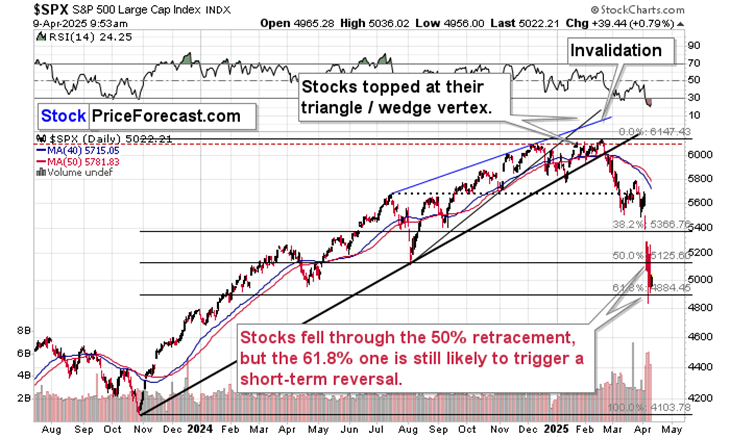
The tariff hikes, the tariff war with China and the latter’s response – it’s all TERRIBLE for the stock market. And yet, despite escalation, stocks are NOT moving to new lows today. Instead, they moved higher, after previously testing the 61.8% Fibonacci retracement level.
Even if stocks moved lower but only slightly so, it would still be a BULLISH reaction. Yes, bullish, because given what’s happening in the world right now, stocks “should” be moving even lower.
This reaction tells us that for the moment, emotions (fear) peaked temporarily and a rebound is necessary simply because of that. That’s what the heavily oversold RSI has been suggesting, and today’s reaction (lack thereof) is even clearer.
Also, today’s rally in gold shows just how concerned people got – and yet, they haven’t sold their stocks.
So, I’m standing by my previous forecast – that we’re about to see a rebound in stocks.
Meanwhile, FCX (my top shorting candidate, but not yet; we just took profits from the previous short) is back above the $30 level.
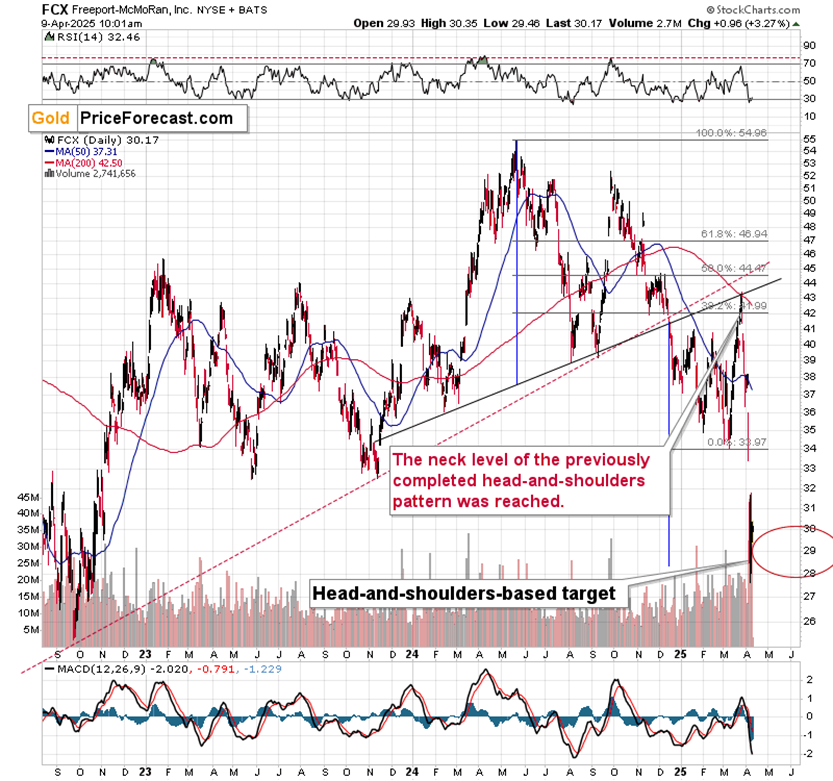
We’ll probably re-short it around $33 as that’s where we have the 2023 lows and the previous low before the massive price gap. My intuition tells me that FCX might want to try to close this gap before declining further.
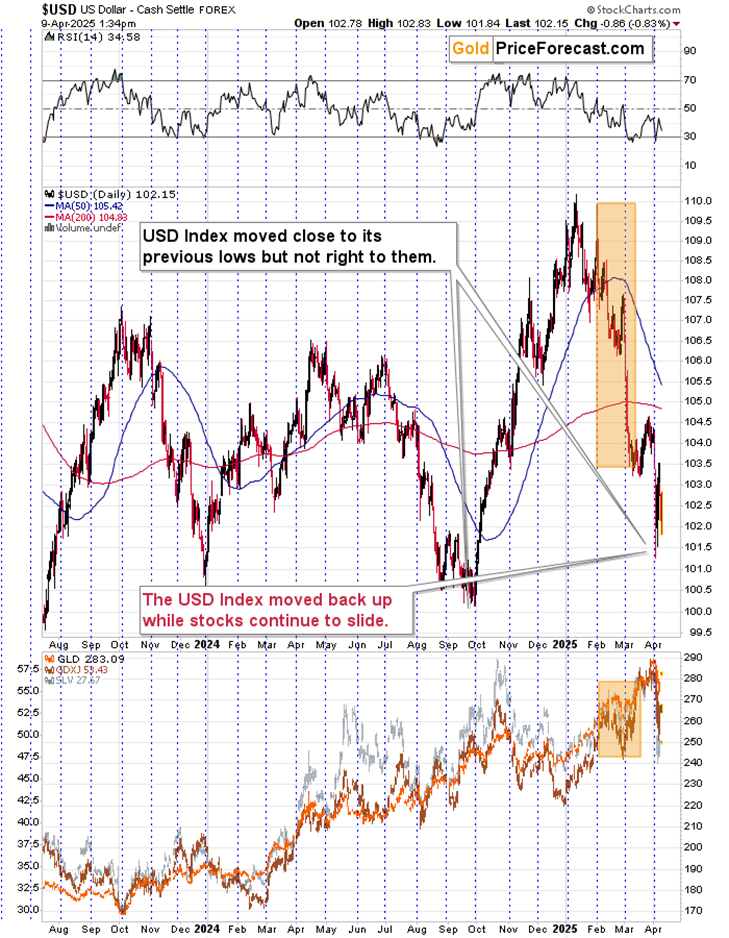
The USD Index declined a bit, but it seems to be a very emotional reaction to what’s happening in the world right now. As I wrote in the first part of today’s analysis – the USD Index is likely to strengthen substantially in the following weeks and months.
Having said that, let’s move to gold, starting with yesterday’s quote:
Gold price itself moved back above the $3,000 level and it also invalidated the breakdown below its rising support line.
How high can gold go during this corrective upswing? My best bet right now is the $3,080 - $3,110 area, but with this kind of volatility, I might need to update this target frequently (and I will).
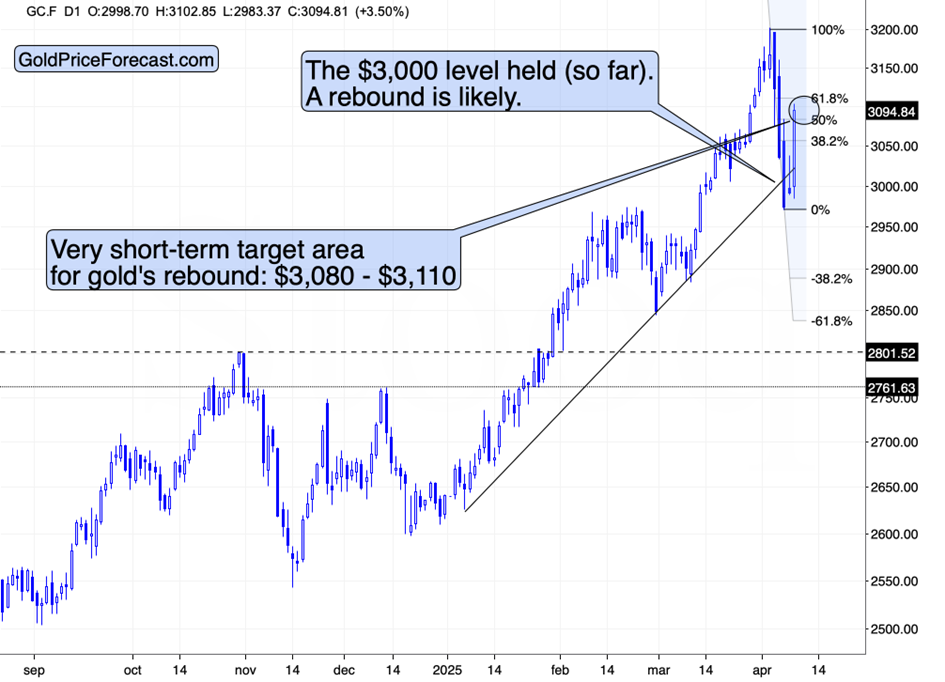
Today’s intraday high of $3,102.85 is right within my above-described target area.
Did gold top here? That’s quite possible (I’m not betting my money on it, though), as given China’s retaliation we might have achieved peak uncertainty today (people’s online searches for gold and silver IRA investments near them soared recently). Or gold could move a few dollars higher before declining.
Before wrapping it up, I’d like to show you one more thing. The disappointing chart featuring the “new gold”.
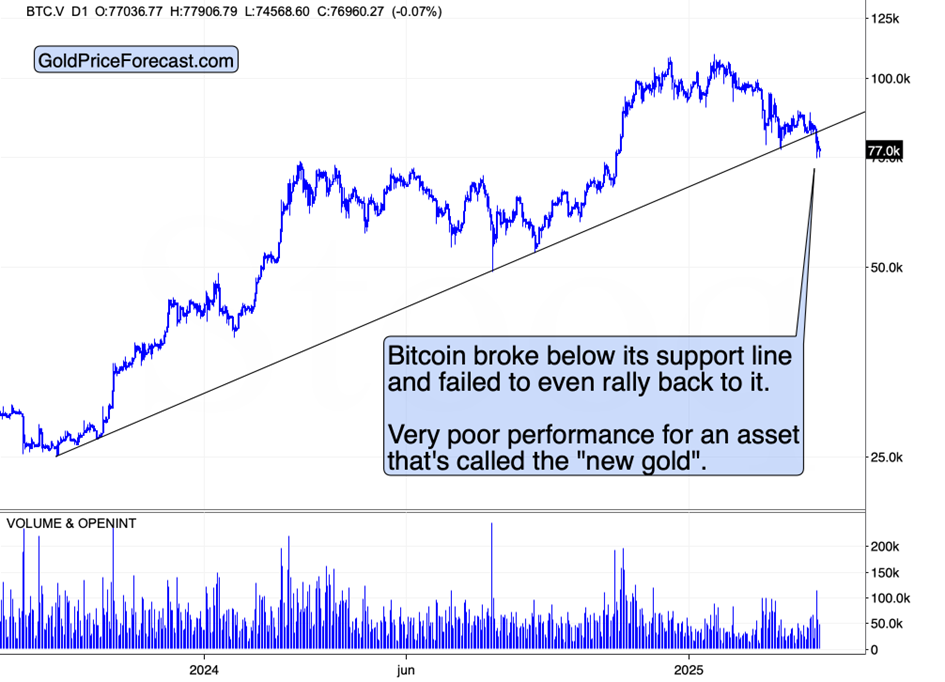
The “new gold” doesn’t provide any protection amid market turmoil or world chaos.
The new anti-dollar asset doesn’t rally amid dollar’s decline.
Instead, bitcoin broke below its rising, medium-term support line, and it confirmed this breakdown, as yesterday was the third close below this line.
Is THE top in bitcoin in? The one for 2025? Probably yes. Is this also a “forever top”? Could be.
